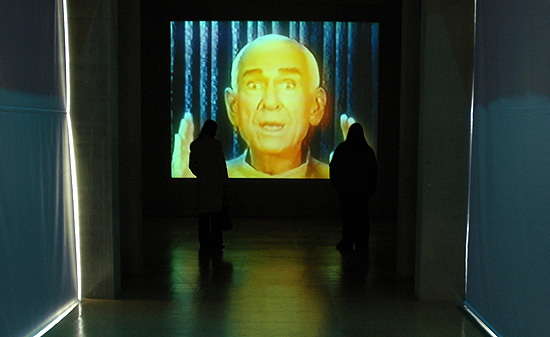Pop Culture, Extremists and a Disco Beat at Zilkha Gallery
 |
| Robert Boyd’s Xanadu is on display in Zilhka Gallery through March 4. |
| Posted 02/01/07 |
| A new exhibit at the Ezra and Cecile Zilhka Gallery tweaks, condenses, and re-frames contemporary events into montages of quick cuts, representing a history of apocalyptic thought as a series of MTV-style music videos within a setting reminiscent of a discotheque.
Robert Boyd’s Xanadu is a synchronized four-channel video installation that probes society’s self-destructive impulse and parodies avenues of popular culture such as documentaries, news media, cartoons, and pop music. Xanadu takes its title from the 1980 American pop musical starring Olivia Newton-John. One of the extraordinary things about Xanadu, beyond its content, is the way it engages the viewer physically and how that engagement actually relates to and reinforces its meaning, says Nina Felshin, curator of exhibitions for the Center for the Arts. In order to see all the projections, the viewer is forced to move around. The soundtrack of upbeat disco music not only provides a disjunctive counterpoint to the often horrific images of destruction but it makes you want to move your body to the beat of the music. Hundreds of hours of archival footage of doomsday cults, iconic political figures, and global fundamentalist movements were mined for the exhibition. Introducing the theme of the Apocalypse, Boyds video Heavens Little Helper (2005) begins with an excerpt from Masada, a 1981 mini-series about The Zealots, a sect of Jews who defended their right to be free from an oppressive Roman regime but who finally succumbed through an act of mass suicide. Fast-forwarding into family footage of seemingly wholesome hippies and children dancing in natural settings, Boyd marks the end of sunny popular culture in the U.S. with iconic images of the Manson Family. Continuing in this vein, the video incorporates archival footage of some of the most infamous doomsday-cult gurus and their devout disciples. While this is not the intention of the artist, I came away feeling that if we don’t do something, if we don’t challenge what’s being served up to us, we will meet essentially the same fate as the victims represented in Boyd’s Xanadu, Felshin says. There is a subtext to this work which, as an activist I would characterize as a call to action or resistance. Robert Boyd is an interdisciplinary installation artist who lives and works in Brooklyn, N.Y. Xanadu premiered at Participant, Inc., in New York in 2006, and has also been presented in Beijing and London. The artist suggests that Xanadu is a conglomerate of our fears, paranoia, and prejudicesan envisioned Apocalypse in the process of becoming reality. Xanadu is on display through March 4 in the Ezra and Cecile Zilkha Gallery, 283 Washington Terrace. Gallery hours are noon to 4 p.m. Tuesday through Sunday and noon to 8 p.m. Friday. A New York Times review of Xanadu is online at http://query.nytimes.com/gst/fullpage.html?res=9402E6DE1F3FF936A35756C0A9609C8B63. |

